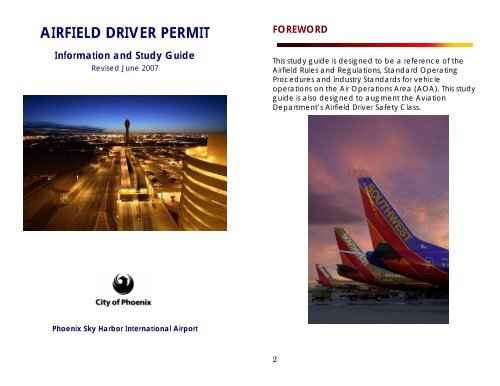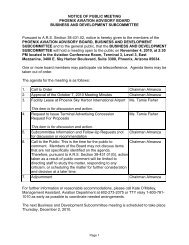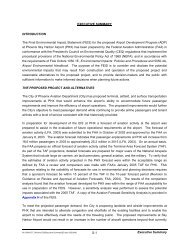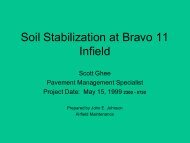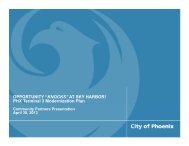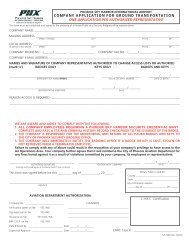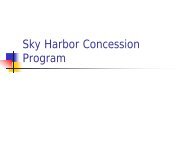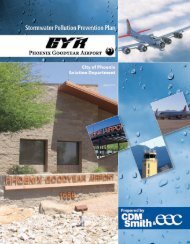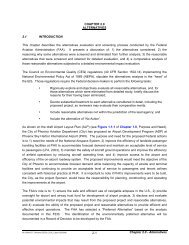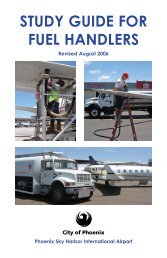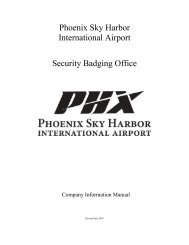AIRFIELD DRIVER PERMIT - Phoenix Sky Harbor International Airport
AIRFIELD DRIVER PERMIT - Phoenix Sky Harbor International Airport
AIRFIELD DRIVER PERMIT - Phoenix Sky Harbor International Airport
Create successful ePaper yourself
Turn your PDF publications into a flip-book with our unique Google optimized e-Paper software.
<strong>AIRFIELD</strong> <strong>DRIVER</strong> <strong>PERMIT</strong><br />
Information and Study Guide<br />
Revised June 2007<br />
FOREWORD<br />
This study guide is designed to be a reference of the<br />
Airfield Rules and Regulations, Standard Operating<br />
Procedures and Industry Standards for vehicle<br />
operations on the Air Operations Area (AOA). This study<br />
guide is also designed to augment the Aviation<br />
Department’s Airfield Driver Safety Class.<br />
<strong>Phoenix</strong> <strong>Sky</strong> <strong>Harbor</strong> <strong>International</strong> <strong>Airport</strong><br />
2
INTRODUCTION...................................................................... 4<br />
General Information..........................................................5<br />
Policy.................................................................................. 6<br />
Authority............................................................................. 6<br />
Procedures .........................................................................7<br />
1. Notice of Violation (NOV) ........................................... 9<br />
2. Suspension of Permit ...................................................10<br />
AOA SECURITY......................................................................12<br />
Authorized Vehicles ........................................................12<br />
Vehicle Access ................................................................12<br />
Vehicle Escorts .................................................................12<br />
AIR OPERATIONS AREA .......................................................14<br />
Non-Movement Areas........................................................14<br />
Foreign Object Debris FOD…………………………………...17<br />
General Points to Remember when Driving on AOA..... 17<br />
Safety Areas.........................................................................18<br />
Taxiway Information .......................................................... 20<br />
A. Taxiway Markings ................................................... 20<br />
B. Taxiway Lighting...................................................... 20<br />
C. Taxiway Signs.......................................................... 20<br />
Runway Holding Position Marking (Hold Bars) ............21<br />
Runway Information...... Error! Bookmark not defined.<br />
A. Runway Markings ...............Error! Bookmark not<br />
defined.<br />
B. Runway Lighting Error! Bookmark not defined.<br />
C. Runway Signs.......................................................... 22<br />
AOA GROUND VEHICLE OPERATIONS.............................. 23<br />
General Procedures....................................................... 23<br />
Parking Restrictions......................................................... 24<br />
<strong>Airport</strong> Removing Vehicles............................................ 25<br />
Right-of-way .................................................................... 25<br />
Prohibitions....................................................................... 25<br />
Baggage Carts ............................................................... 26<br />
Construction Vehicles.................................................... 26<br />
3<br />
Use of Roadways ............................................................ 26<br />
Operating Speeds ...........................................................27<br />
The Air National Guard Base ........................................ 28<br />
Insurance Requirements................................................ 29<br />
West/East Bridge Drives ................................................. 29<br />
Vehicle Accidents .......................................................... 30<br />
HAZARDOUS MATERIAL OPERATIONS............................... 32<br />
Fuel Handling .................................................................. 32<br />
Fuel Spills .......................................................................... 33<br />
Fuel Spill Control.............................................................. 33<br />
Storm Drain Issues ........................................................... 34<br />
Smoking............................................................................ 34<br />
AIRCRAFT OPERATIONS...................................................... 36<br />
Takeoffs and Landings................................................... 36<br />
Taxiing............................................................................... 36<br />
Parking.............................................................................. 36<br />
Pushing Back ....................................................................37<br />
Engine Run-Ups ................................................................37<br />
Helicopter Operations ....................................................37<br />
DEFINITIONS......................................................................... 38<br />
PHONETIC ALPHABET .......................................................... 43<br />
REFERENCES...………………………….………………………45<br />
INTRODUCTION<br />
Purpose<br />
The purpose of presenting the airfield driver safety class<br />
is to provide training to all individuals who operate<br />
vehicles and/or equipment on the non-movement<br />
area of the airfield. Access to movement areas<br />
requires additional training and approval by Airside<br />
4
Operations. The intent of this study guide is to supply<br />
the reader with information on procedures<br />
recommended for safe vehicle operations on the Air<br />
Operations Area (AOA) and other restricted areas at<br />
<strong>Phoenix</strong> <strong>Sky</strong> <strong>Harbor</strong> <strong>International</strong> <strong>Airport</strong> (<strong>Airport</strong>). The<br />
information in this study guide is extracted from<br />
appropriate Airfield Rules and Regulations, Federal<br />
Aviation Regulations, Advisory Circulars, State of<br />
Arizona Title 28 Criminal Code and the Aviation<br />
Department Standard Operating Procedures.<br />
General Information<br />
Each individual whose job duties require that he/she<br />
traverse the AOA at <strong>Phoenix</strong> <strong>Sky</strong> <strong>Harbor</strong> <strong>International</strong><br />
<strong>Airport</strong> is required to obtain an Airfield Driver’s Permit<br />
(ADP) before operating a vehicle on any portion of the<br />
airfield. Permit use is limited to work related areas<br />
during work hours only. A valid U.S. state issued driver’s<br />
license is also required to operate a vehicle on the<br />
AOA.<br />
It is the responsibility of all companies operating at the<br />
airport to inform their employees of the driving permit<br />
program and the necessity to obtain a driving permit.<br />
In addition, companies operating vehicles on the<br />
airfield are required to have five million dollars<br />
($5,000,000) auto liability insurance coverage, naming<br />
the City of <strong>Phoenix</strong> as “Additional Insured.” Contact<br />
<strong>Airport</strong> Security Badging at (602) 273-2036 for more<br />
information.<br />
New employees will not be allowed to operate a<br />
vehicle/equipment on the airfield unless escorted by<br />
an experienced employee who holds a valid Airfield<br />
Driver’s Permit (ADP). If your company cannot provide<br />
escort, contact the Operations supervisor at (602)273-<br />
5<br />
2008 at least 24 hours prior to your arrival and an escort<br />
will be provided.<br />
Employees, who receive a security badge with an<br />
Airfield Driver’s Permit, will have the permit included on<br />
their badge in the shape of a car on the lower left<br />
corner on the front of the badge.<br />
Policy<br />
The goal of this program is safety through strict<br />
compliance with airfield regulations. Accomplishing this<br />
goal requires airlines, tenants and other users of the<br />
airfield work closely with the Aviation Department to<br />
promote strict adherence to the rules and regulations<br />
pertaining to the airfield. An Enforcement Program is in<br />
place to monitor and enforce these regulations.<br />
Other major goals of the program are to:<br />
1. Provide initial training for new employees and<br />
refresher training for all current employees in vehicle<br />
operations on the airfield.<br />
2. Stress the importance of safety procedures to<br />
prevent personal injury and property damage<br />
accidents.<br />
Authority<br />
A driver may be required to prove his/her authority to<br />
operate a vehicle or equipment on airport property by<br />
providing a current valid <strong>Airport</strong> Security Badge with<br />
Driver’s Endorsement and a current valid state driver’s<br />
license to an Aviation Department representative for<br />
inspection at their request.<br />
If the driver fails to show a permit and license, he/she<br />
will not be allowed to continue operating a<br />
vehicle/equipment in the restricted area and will be<br />
issued a Notice of Violation (NOV).<br />
6
Procedures<br />
A. Permit Application<br />
Applications and study materials for the Airfield Driver<br />
Permit test may be obtained at the Security Badging<br />
Office located at the <strong>Airport</strong> Operations Center.<br />
Security Badging Office hours and further information<br />
may be obtained by calling (602)273-2036.<br />
B. Permit Process<br />
1. Required Permit Materials<br />
a. Materials<br />
The Aviation Department’s “Airfield Driver Permit<br />
Information and Study Guide” pamphlet will be<br />
mandatory reading prior to the test being given.<br />
b. Pre-requisites<br />
Applicants must possess a current valid U.S. state issued<br />
driver’s license and either be in possession of, or be<br />
concurrently applying for an <strong>Airport</strong> Security badge<br />
before applying for the Airfield Driver’s Permit.<br />
2. Training<br />
The City of <strong>Phoenix</strong> Aviation Department Operations<br />
Division will provide training for all employees needing<br />
an airfield driver’s permit. In addition, companies are<br />
encouraged to provide training and familiarization rides<br />
prior to sending the employee to Operations for the<br />
formal training and testing.<br />
3. Testing<br />
The Operations Division will conduct testing of all<br />
applicants.<br />
b. Examination Content<br />
The computerized examination will consist of multiple<br />
choice and true or false questions and will cover<br />
material from the study guide.<br />
c. Exam Failures<br />
Answering three questions wrong in the row constitutes<br />
a failure. Applicants who fail the initial test will be<br />
required to take a test again on another day.<br />
Individuals passing the retest examination will then be<br />
issued an Airfield Driver’s Permit.<br />
Those individuals who fail the retest examination will be<br />
instructed to take a few days to thoroughly study the<br />
information contained in the study guide pamphlet<br />
and will then be allowed to reschedule to take the test<br />
again. These individuals will not be permitted to<br />
operate a vehicle on the airfield until they have<br />
successfully passed the examination and have been<br />
issued the Airfield Driver’s Permit.<br />
4. Issuance of Permit<br />
The Security Badging Office will issue all Airfield Driver’s<br />
Permits.<br />
C. Tenure of Permit<br />
The Expiration of the Airfield Drivers Permit will coincide<br />
with the expiration of the <strong>Airport</strong> Security Badge.<br />
Driver’s permits may also be revoked or suspended as a<br />
result of the issuance of a Notice of Violation.<br />
a. Testing Responsibility<br />
7<br />
8
D. Lost Badge with Driver’s Permit<br />
A driver who loses his/her Badge with Airfield Driver’s<br />
Permit is responsible for reporting the loss immediately<br />
to the Operations Division by calling the <strong>Airport</strong> Security<br />
Badging Office at 602-273-2036. A replacement badge<br />
may then be acquired from the <strong>Airport</strong> Security<br />
Badging Office during business hours. A new badge<br />
application will be required for replacement badges<br />
and replacement fees may apply.<br />
E. Badge Renewal<br />
At the time of renewal, individual records will be<br />
reviewed. If the badge has expired, the individual will<br />
be required to retake the driver’s training class. Check<br />
with a Security Badging Office representative in the<br />
Operations Division for further information.<br />
F. Enforcement<br />
The Aviation Department has authorized the<br />
Operations Section and the <strong>Phoenix</strong> Police Department<br />
to conduct inspections and enforce violations<br />
regarding safety on the airfield ramps. All violators will<br />
be subject to citation and/or Notice of Violation (NOV).<br />
1. Notice of Violation (NOV)<br />
An NOV (Figure 1) will be issued for observed violations<br />
of any rules, regulations and laws governing or<br />
established for the safe and orderly conduct while on<br />
the airport.<br />
The Notice of Violation will be monitored and issued by<br />
the Deputy Aviation Director of Operations or his/her<br />
designated representative.<br />
Figure 1<br />
9<br />
*****Print Shop: Please Insert an Image of Form 121-89D<br />
Rev 9/04*****<br />
10<br />
2. Suspension of Permit<br />
a. Severe Violation<br />
Any driving violation of a severe nature (i.e., a violation<br />
resulting in property damages and/or injury, runway<br />
incursions) as determined by the Deputy Aviation<br />
Director of Operations or his/her representative will<br />
warrant immediate suspension or revocation of permit.<br />
b. Three Notices of Violation<br />
Three (3) Notices of Violation issued for driving<br />
infractions within a twenty-four (24) month span will be<br />
considered grounds for suspension of an individual’s<br />
Badge with Airfield Driver’s Permit.<br />
c. Length of Suspension<br />
Suspension will be for up to a one hundred eighty (180)<br />
day period. Employees may not be escorted into a<br />
restricted area during the timeframe their badge is<br />
suspended. Severe or repetitive violations may result in<br />
permanent revocation of the Airfield Driver’s Permit.<br />
d. Hearing<br />
After receiving a Notice of Violation, you have five (5)<br />
business days to call 602-683-3651 to schedule a<br />
hearing. Failure to schedule a hearing within five (5)<br />
business days will result in the deactivation of the<br />
employee’s Security Badge. Employees must attend<br />
the hearing with their immediate supervisor.<br />
The hearing serves as an opportunity to identify the<br />
nature of the infraction, and to educated airport<br />
employees about airport rules and regulations.
Penalties may range from remedial training to badge<br />
suspension or revocation depending on the severity of<br />
the offense and the employee’s prior record.<br />
AOA SECURITY<br />
Authorized Vehicles<br />
All vehicles on the AOA must be marked with the<br />
company name and/or logo, or display a numbered<br />
top hat, in a manner approved by the Deputy Director<br />
of Operations or his/her designated representative. The<br />
company name must be displayed in at least 4” high<br />
lettering and/or the company logo must be a minimum<br />
12” in diameter or a minimum of 144 square inches<br />
including logo and name. Logos must be displayed on<br />
both sides of the vehicle. Unmarked vehicles must be<br />
escorted and identified with a numbered top hat while<br />
on the AOA. This hat will be issued when the vehicle is<br />
registered at the staffed vehicle gate.<br />
Vehicle Access<br />
Vehicle access to the AOA is obtained through staffed<br />
gates. It is important that you comply with the Security<br />
Guard instructions. When accessing the AOA the driver<br />
must wait until the gate is closed before leaving the<br />
gate. Failure to wait for gate closure is a security<br />
violation and could result in revocation of the driver’s<br />
security badge.<br />
Vehicle Escorts<br />
The following procedures must be followed when<br />
providing an escort on the AOA.<br />
A. The company/individual to be escorted must arrive<br />
at a staffed gate and inform the security guard of<br />
their destination on the AOA. Vehicle is searched in<br />
accordance with current security directives.<br />
11<br />
12
B. The driver of the escorted vehicle must exchange<br />
their valid U.S. State issued Driver’s License for the<br />
vehicle top hat. All other passengers in the vehicle<br />
will need to show either their valid <strong>Airport</strong> Security<br />
Badge or valid government issued photo ID.<br />
C. All vehicle escorts must process through the staffed<br />
security gates. Currently, the staffed gates are 103,<br />
116, 141, 220, and 248.<br />
D. The company/individual is informed that any<br />
movement on the AOA without proper escort will<br />
result in a NOV and/or a citation.<br />
E. The person providing the escort must make contact<br />
with the security guard prior to taking the<br />
company/individual airside and register showing<br />
their valid Drivers License and current SIDA (Security<br />
Identification Display Area) badge with ADP icon.<br />
F. The individual providing escort must remain with the<br />
company/individual being escorted in the AOA at<br />
all times. Failure to follow this procedure will result in<br />
an NOV and/or a citation.<br />
G. The individual performing the escort will escort<br />
company/individual back to the same staffed gate<br />
when the work is completed.<br />
H. The company/individual being escorted will return<br />
the numbered top hat to the security guard in<br />
exchange for return of his/her ID.<br />
I. The individual providing escort may now leave the<br />
escorted company/individual.<br />
J. Vehicles delivering hazardous materials will not be<br />
escorted through tunnels and underneath bridges or<br />
buildings. Drivers of these vehicles must contact<br />
Airside Operations at 602-273-2008 to be escorted<br />
via different routes.<br />
13<br />
AIR OPERATIONS AREA (AOA)<br />
Description<br />
The AOA can easily be divided into two separate<br />
areas, movement area and non-movement area<br />
(Figure 2).<br />
A. To operate a vehicle in the movement area<br />
clearance must first be obtained from the Airside<br />
Operations and the Air Traffic Control Tower (ATCT).<br />
You must either have a movement area certification<br />
or be under the escort of someone who is certified<br />
to be in the movement area. In either case, you<br />
must always contact Airside Operations and ATCT<br />
for approval prior to accessing any movement area.<br />
Movement Area certification is designated by an<br />
airplane icon in a lower left corner of the security<br />
badge.<br />
****Insert Map of PHX with movement area****<br />
Movement Areas<br />
Vehicle Roadway<br />
Gates 220 and 141<br />
14<br />
B. The non-movement areas are aprons and aircraft<br />
parking areas (including vehicle/tug roadways).<br />
No clearance is required from Airside Operations<br />
or <strong>Airport</strong> Traffic Control Tower to operate in a<br />
non-movement area.<br />
Non-Movement Areas<br />
Before driving anywhere on the AOA, know the<br />
location of the boundary between the non-movement
area and the movement area. This can be identified<br />
by a “Non-movement Area Boundary Marking.” You<br />
may not cross into a movement area without<br />
permission from Airside Operations and Air Traffic<br />
Control (ATC).<br />
Ramps/Aprons<br />
These are areas where aircraft are parked, loaded and<br />
unloaded, and serviced between flights. Vehicles and<br />
aircraft operate in close proximity in these areas, so it is<br />
vital to maintain a safe distance between your vehicle<br />
and aircraft.<br />
Always yield to aircraft and never drive under an<br />
aircraft or its wings. Slow speed and extreme caution<br />
are required in these areas. Always drive in vehicle<br />
lanes if they are marked.<br />
Perimeter Roads<br />
Perimeter roads provide vehicle access from one area<br />
of the airfield to another. Even though the travel<br />
distance and time may be longer, always use a<br />
perimeter road or service road when it is available. This<br />
increases safety awareness for pilots and they are able<br />
to better recognize vehicles traffic.<br />
Markings on Non-Movement Areas<br />
15<br />
Ramps/aprons may contain a variety of markings for<br />
aircraft parking, tiedowns, or vehicle lanes. You may<br />
also see markings that identify the boundary between<br />
the non-movement area and the movement area that<br />
is under Air Traffic Control (ATC). These markings consist<br />
of two yellow lines—one solid, one dashed.<br />
*****Picture*****<br />
The dashed line is located on the movement side—the<br />
area controlled by ATC. The solid line is on the nonmovement<br />
side. Always stay in the non-movement<br />
area unless you are authorized by Airside Operations<br />
and have permission from the control tower to be in the<br />
movement area. If there is no boundary marking<br />
present between the movement and non-movement<br />
area, check with Airside Operations to find out where<br />
the actual boundary is located.<br />
Driving in Non-Movement Areas<br />
Know where the boundary is between movement<br />
and non-movement areas.<br />
Always use perimeter roads.<br />
Unless otherwise posted, the speed limit is 15 mph or<br />
less.<br />
Never drive behind an aircraft that is being pushed<br />
back. This can be identified by beacon, wing<br />
walkers, jetway pulled back, etc.<br />
Use vehicle lanes when marked.<br />
Do not drive through fuel spills—they can ignite.<br />
Do not block fire lanes.<br />
Beware of the danger of jet blast and prop wash—<br />
watch for flashing beacons on aircraft to indicate<br />
the engine is running or about to start.<br />
16
General Points to Remember when Driving on<br />
AOA<br />
• Always know your exact location and be aware of<br />
activity around you.<br />
• Never drive under any part of an aircraft or allow its<br />
wing to pass over your vehicle.<br />
• Maintain a safe distance from parked or taxiing<br />
aircraft.<br />
• Aircraft always have the right-of-way.<br />
• Display proper identification and security access<br />
permits on the outermost garment above waist level<br />
• Pilots have a limited field of view from the cockpit—<br />
don’t assume they can see you.<br />
• Be aware of emergency vehicles—always yield to<br />
them.<br />
• Immediately report any accident, no matter how<br />
minor, to your supervisor and <strong>Airport</strong> Operations at<br />
(602)273-3311.<br />
• Use extreme caution when driving at night and/or in<br />
poor weather conditions.<br />
• Realize that you can become disoriented even in the<br />
best conditions—when disoriented, stop and request<br />
assistance.<br />
• Be alert to any foreign object debris (FOD)—either<br />
pick it up or notify someone who can.<br />
FOD<br />
Foreign Object Debris is any debris on the airfield that<br />
can cause damage to an aircraft. A few examples are<br />
tools, plastic packing material, cans, rocks, or<br />
discarded parts from maintenance activities. Any of<br />
these objects can shred internal parts if sucked into a<br />
jet engine and can become deadly projectiles. FOD<br />
17<br />
can create a hazard during taxiing, takeoff, and<br />
landing. Therefore, it is crucial that everyone on the<br />
airfield be alert to FOD and dispose of it immediately.<br />
You assistance with FOD prevention is critical. Think of<br />
your family members traveling on an airliner and how<br />
safe you want them to be. FOD awareness/prevention<br />
is everyone’s business.<br />
Example: A Boeing 757 engine has 22 blades at a cost<br />
of $42,323 each. A Boeing 737 has 38 blades at a cost<br />
of $11,000 each. A spinner of the front end of the<br />
engine cost $4,500.<br />
Safety Areas/Object Free Areas<br />
A safety area is a designated area abutting the edges<br />
of a runway or taxiway, intended to reduce the risk of<br />
damage to an aircraft inadvertently leaving the<br />
runway or taxiway.<br />
Service roads are located in some areas where it is not<br />
possible to obtain standard safety areas<br />
The airport has identified impacted areas with zipper<br />
markings as seen in the pictures below. The vehicle<br />
lane entering the safety area is marked with a white<br />
bar and the letters “RSA” (Runway Safety Area) and<br />
OFA (Object Free Area). The zipper markings on the<br />
roadway edges continue until the vehicle exits the<br />
RSA/OFA.<br />
Employees entering these areas must exercise extreme<br />
caution. They should expedite at a safe speed through<br />
the area, and should never stop or park their vehicle.<br />
Employees must give way to aircraft at all times, which<br />
may require deviating off of the vehicle roadway.<br />
Please contact the Airside Operations Supervisor (602)-<br />
273-2008 with any questions.<br />
18
Taxiway Information<br />
A taxiway is a prepared strip used for the movement of<br />
aircraft on the airport surface to transition from the<br />
runway to the apron and vice versa.<br />
A. Taxiway Markings<br />
All taxiways have a<br />
yellow centerline<br />
stripe, yellow leadin<br />
lines, double<br />
yellow edge stripe<br />
and double yellow<br />
lines abutting an<br />
apron.<br />
Taxiway Object Free Area (OFA)<br />
B. Taxiway Lighting<br />
At night and during inclement<br />
weather, the taxiway edges are<br />
illuminated by blue lights and the<br />
taxiway guidance signs are internally<br />
lit.<br />
C. Taxiway Signs<br />
The taxiway entrance from an apron<br />
is identified by a guidance sign that<br />
is yellow with black letters and states<br />
the name of that taxiway. Often a taxiway guidance<br />
sign shows the way to another taxiway by stating the<br />
taxiway letter and a directional arrow.<br />
19<br />
20
Runway Holding Position Marking (Hold Bars)<br />
A hold bar is a set of parallel lines painted on a taxiway<br />
used to mark the entrance into the runway safety area<br />
(Figure 3). The runway-side of the hold bar is under<br />
tower frequency control, while the taxiway side is under<br />
ground frequency control. The hold bar itself is a paired<br />
set of parallel yellow lines, two solid and two dashed.<br />
The solid line indicates the hold bar can be crossed<br />
from that side only after receiving clearance from the<br />
Air Traffic Control Tower. If you approach a hold bar<br />
and you are not authorized to be there, call Airside<br />
Operations for help immediately.<br />
C. Runway Signs<br />
Red and white runway mandatory signs state the<br />
“name” of the runway and its orientation. Only red and<br />
white signs may be used to identify a runway entrance.<br />
These signs are internally lit. All the runways also have<br />
distance to go markers, black signs with white numbers<br />
indicating in thousands of feet the distance to the end<br />
of the runway.<br />
Figure 3: Runway Holding Position Marking<br />
21<br />
22
AOA GROUND VEHICLE OPERATIONS<br />
General Procedures<br />
A. All motor vehicles and ground support equipment<br />
on the AOA of <strong>Phoenix</strong> <strong>Sky</strong> <strong>Harbor</strong> <strong>International</strong><br />
<strong>Airport</strong> must be maintained in generally sound<br />
mechanical condition so as to prevent breakdowns,<br />
excessive leaking of fluids or inability to comply with<br />
other requirements of this procedure.<br />
B. No vehicle will be permitted upon the aircraft areas,<br />
fuel storage areas, ramps and aprons, aircraft<br />
parking and storage areas, unless equipped with<br />
adequate lights, horn and brakes. Clear vision from<br />
the driver’s seat is also required and should be<br />
adhered to.<br />
C. Motor vehicles will be operated only in those areas<br />
of the airport as may be authorized from time to<br />
time by the Aviation Director or his/her designee<br />
and then under the currently established rules.<br />
D. No one will clean or make any repairs to motor<br />
vehicles or equipment anywhere on the airport<br />
other than in a designated shop area, except minor<br />
repairs necessary to remove such disabled vehicles<br />
from the airport. No one will move, interfere, or<br />
tamper with any motor vehicle part, instrument or<br />
tool without the permission of the owner or<br />
satisfactory evidence of the right to do so by the<br />
owner or as approved by the Aviation Director or<br />
his/her designee.<br />
E. All vehicles operated in any portion of the AOA will<br />
continuously display headlights and tail lights at<br />
night and during periods of low visibility. Headlights<br />
should be on low beam.<br />
23<br />
F. All motor vehicles and/or ground support<br />
equipment shall display a rotating amber beacon or<br />
flashing light at all times operating in movement<br />
areas.<br />
G. All drivers operating motor vehicles during nighttime<br />
hours will display courtesy to taxiing aircraft by<br />
angling their vehicle so that headlight beams do not<br />
directly impact aircraft cockpit areas.<br />
H. No vehicle except aircraft handling and servicing<br />
equipment will be driven between an aircraft and a<br />
ground loading gate.<br />
I. No motor vehicle or piece of ground support<br />
equipment will be permitted to stand unattended in<br />
any portion of the AOA, except in authorized<br />
parking areas. If a vehicle or equipment can be<br />
moved so as to present no safety hazard to taxiing<br />
aircraft, it will be considered as being adequately<br />
attended.<br />
J. For security reasons, never leave keys in unattended<br />
vehicles! If a vehicle is not under the direct control<br />
of an authorized employee, the vehicle should be<br />
turned off and the keys are to be removed. In<br />
addition, vehicles parked for extended periods of<br />
time, such as overnight, should be locked.<br />
K. All non-motorized ground support equipment shall<br />
be prominently marked with reflective tape.<br />
Parking Restrictions<br />
No person shall park a vehicle or permit same to remain<br />
halted on any of the following: operational area, fuel<br />
storage area, passenger ramp and apron, cargo ramp<br />
and apron or aircraft parking and storage area except<br />
at such places and for such periods of time as may be<br />
prescribed and posted by the Aviation Director. Aircraft<br />
refueling vehicles will be parked only in areas as<br />
24
designated by the Aviation Director or his/her<br />
designee.<br />
<strong>Airport</strong> Removing Vehicles<br />
Any unauthorized vehicle which has been parked in a<br />
space reserved for specific parking may be removed or<br />
caused to be removed by the Aviation Department as<br />
provided in the <strong>Phoenix</strong> City Code.<br />
Right-of-way<br />
A. All motor vehicles and ground support equipment<br />
must yield within five hundred (500) feet of any<br />
moving aircraft while in any area of the AOA.<br />
Aircraft always have the right of way. Never drive<br />
into the path of any moving aircraft.<br />
B. All vehicles will yield the right-of-way to all<br />
authorized vehicles responding to emergency<br />
situations.<br />
Prohibitions<br />
No vehicle shall be operated in any portion of the<br />
AOA:<br />
1. In a careless or negligent manner.<br />
2. In disregard of the right and safety of others.<br />
3. Without due caution or at a speed or manner which<br />
could endanger persons or property.<br />
4. While the driver is impaired or under the influence of<br />
an intoxicating liquor or any narcotic habit-forming<br />
drug.<br />
5. If it is equipped in a hazardous way or loaded in a<br />
manner this could endanger persons or property.<br />
Baggage Carts<br />
At no time will more than six (6) baggage carts be<br />
towed behind tug vehicles when operating on or<br />
about the AOA and four (4) baggage carts in Terminal<br />
4 basement.<br />
Construction Vehicles<br />
A. Construction vehicles when on the AOA should be<br />
marked and display a three (3 ft) foot by three (3ft)<br />
foot flag with alternating one (1ft) foot by one (1 ft)<br />
foot orange and white checkers or a<br />
flashing/rotating amber beacon for high daytime<br />
visibility. During nighttime operations construction<br />
vehicles shall be lighted with an amber<br />
flashing/rotating beacon and front and rear lights.<br />
B. Vehicles not meeting these requirements must be<br />
escorted by a vehicle that meets the requirements.<br />
Use of Roadways<br />
A. All vehicles must drive within the marked vehicle/tug<br />
roadways to reach their destination (roadway<br />
markings are white). Never drive on runways or<br />
taxiways.<br />
25<br />
26
B. Aircraft servicing operations conducted at gates will<br />
not be subject to these movement requirements.<br />
C. All vehicles not equipped with an amber rotating<br />
beacon, or other lighting system for authorized<br />
emergency vehicles, AND continuous two-way radio<br />
communication access with the <strong>Phoenix</strong> Tower<br />
Ground Control will be limited to transit operations<br />
conducted within the painted vehicle/tug<br />
roadways.<br />
D. At areas where Vehicle Service Road encroach an<br />
Aircraft Object Free areas, vehicles must always give<br />
right of way to aircraft. Example: S/T Bridges.<br />
Operating Speeds<br />
A. The maximum speed for all vehicles and equipment,<br />
with the exception of authorized emergency<br />
vehicles during emergency functions, operated<br />
within the vehicle/tug roadways is 25 miles per hour<br />
unless otherwise marked.<br />
B. Vehicles and equipment operated in all other apron<br />
and terminal service areas must not exceed 15 miles<br />
27<br />
per hour, with the exception of authorized<br />
emergency vehicles during emergency functions.<br />
C. The maximum speed for vehicles operated near<br />
parked aircraft, in the baggage sort areas, around<br />
hangars and on the West and East Bridge Drives at<br />
Terminal 3 is 5 miles per hour.<br />
D. The maximum speed for all motor vehicles and<br />
ground support equipment operated in aircraft<br />
safety areas, such as runways and taxiways, will be<br />
determined by the operator in accordance with<br />
operational necessity and safe operating practices.<br />
E. The maximum speed for construction vehicles will be<br />
determined by the Deputy Director of Operations or<br />
his/her designee and will be based on the<br />
construction site location and operational necessity.<br />
F. The maximum speed in Terminal basement areas<br />
must not exceed 10 miles per hour.<br />
Note: The above referenced speed limits may never be<br />
exceeded. Keep in mind that normal operational<br />
speeds will be lower than the speed limit based on<br />
weather conditions and other factors. Authorized<br />
Emergency Response vehicles may exceed posted<br />
speed limit to the extent necessary to meet the needs<br />
of the emergency.<br />
The Air National Guard Base<br />
The Air National Guard Base area is separated from<br />
AOA by a red and white solid line and surface painted<br />
signs. The Air Guard is authorized to use “Deadly Force”<br />
to protect their base and assets. Unauthorized crossing<br />
of the red line, whether inadvertent or intentional will<br />
result in suspension of <strong>Airport</strong> Badge privileges for a<br />
minimum of 180 days Do not cross the red line without<br />
an escort from the Air National Guard.<br />
28
intended for use as a traffic route for air carrier tugs<br />
and baggage carts, practicality dictates that some use<br />
of the bridge drive by the airlines is appropriate.<br />
The bridge drive situated on the east end of the<br />
Terminal 3 service level is designed to be utilized for<br />
local baggage cart movement. The airlines are<br />
encouraged to use this drive whenever possible. Use of<br />
this Bridge Drive by others is restricted.<br />
Hazardous Materials<br />
Any vehicle carrying hazardous materials is prohibited<br />
from driving under any portion of the terminals.<br />
Insurance Requirements<br />
No one may operate a motor vehicle on or within the<br />
AOA at <strong>Phoenix</strong> <strong>Sky</strong> <strong>Harbor</strong> <strong>International</strong> <strong>Airport</strong> without<br />
having valid automobile liability insurance policy to<br />
provide coverage for liability arising from bodily injury<br />
and property damage. The City of <strong>Phoenix</strong> must be<br />
named as certificate holder and additional insured on<br />
the policy. Anyone violating this regulation could be<br />
guilty of a Class 1 misdemeanor and will be subject to:<br />
(a) fine not exceeding one thousand dollars ($1,000),<br />
(b) imprisonment for a term not exceeding six (6)<br />
months, or (c) both. Contact the <strong>Airport</strong> Security Office<br />
at (602) 273-2036 for more information.<br />
Vehicle Accidents<br />
The driver of any motor vehicle involved in any<br />
accident while on the AOA must report the accident<br />
by calling 602-273-3311. In the event of injury the driver<br />
shall render assistance as needed until emergency<br />
vehicles arrive.<br />
Terminal 3 Bridge Drives<br />
The bridge drive situated on the west end of the<br />
Terminal 3 service level is intended to be utilized by the<br />
Aviation Department employees. Other users of this<br />
bridge will include vendors delivering goods to the<br />
Terminal 3 concessionaires. Though this bridge is not<br />
29<br />
30
HAZARDOUS MATERIAL OPERATIONS<br />
Fuel Handling<br />
A. Employees must attend additional training and<br />
receive a fuel handler’s certification to be eligible to<br />
dispense fuel at <strong>Phoenix</strong> <strong>Sky</strong> <strong>Harbor</strong> <strong>International</strong><br />
<strong>Airport</strong>.<br />
B. During all fuel handling operations involving fuel<br />
dispensing or the draining of fuel from aircraft, the<br />
aircraft and apparatus must be bonded to prevent<br />
the possibility of static ignition of hazardous liquids.<br />
C. Refueling units will be stored outside, not less than<br />
fifty (50) feet from a building or aircraft or such other<br />
distance as shall be approved by the Aviation<br />
Director or his/her designee. Exceptions to this rule<br />
apply only when minor adjustments or repairs are<br />
necessary to move such units to a storage area<br />
31<br />
32
when failure occurs elsewhere on the airport. No<br />
fuel vehicle, empty or otherwise, will be brought into,<br />
kept or stored within any building at the airport.<br />
D. All motorized equipment must be parked so that it<br />
may be readily driven or towed away from the<br />
aircraft in case of emergency. They must be parked:<br />
1. In a clear space<br />
2. 10 feet apart from each other<br />
3. 50 feet from building or parked aircraft<br />
4. In a matter to prevent fuel from leaking into<br />
storm drains<br />
Fuel Spills<br />
Because of the highly flammable nature of fuel, all fuel<br />
spills, regardless of the amount spilled or who will be<br />
providing the cleanup, must be reported to 602-273-<br />
3311. The Fire Department will either apply a flash<br />
inhibitor or stand by while the spill is being cleaned up.<br />
This activity may leave a wet and messy residue, so<br />
further cleanup may become necessary. Both of these<br />
activities require extensive labor and equipment which<br />
is very costly. These service charges will be directly<br />
billed to the organization responsible for the incident. A<br />
company that fails to notify the City of a fuel spill will be<br />
assessed an additional charge of three hundred dollars<br />
($300) according to P.C.C. §32-106(e).<br />
Fuel Spill Control<br />
The reporting party shall immediately initiate the<br />
following:<br />
1. Set up a barrier by retaining or diking, thus<br />
preventing the passage of the materials to an area<br />
where it is more hazardous or into nearby drains or<br />
swales.<br />
2. If the spill poses no danger to you...stop the spill.<br />
3. Report all spills to your supervisor.<br />
At convenient locations on the terminal ramps, there<br />
are large, yellow, plastic containers marked “FUEL SPILL<br />
KIT”. These containers have approved absorbent<br />
materials which should control the spread of fuel until<br />
the appropriate clean up measures have been<br />
determined. Keep all spills from flowing into a storm<br />
drain or sanitary drain. Used absorbent should not be<br />
returned to the containers. The City will dispose of the<br />
absorbent material.<br />
Storm Drain Issues<br />
The storm drain system at the airport is regulated under<br />
the Clean Water Act (CWA) by the Environmental<br />
Protection Agency (EPA) to protect the surface water.<br />
Any discharge into storm drains or catch basins, except<br />
unpolluted storm runoff, is a violation of the Clean<br />
Water Act (CWA). Activities that have the potential to<br />
release pollutants into storm drain systems include:<br />
outdoor open storage of materials and chemicals,<br />
aircraft or vehicle washing in unapproved areas, fuel<br />
spills, and deliberate dumping of wastes or chemicals.<br />
Smoking<br />
A. Smoking is only authorized in Designated Smoking<br />
Areas. No person will smoke on any ramp area, in<br />
any shop area, hangar area, or other building<br />
where it is considered dangerous to do so and<br />
which has been specifically prohibited by the<br />
Aviation Director or his/her designee.<br />
33<br />
34
B. No person will smoke or carry lighted cigars,<br />
cigarettes, pipes, matches or any item with open<br />
flame in or upon any place where smoking is<br />
specifically prohibited by signs.<br />
C. Penalties may range from an NOV to Civil penalties<br />
in accordance with Smoke-Free Arizona Act A.R.S.<br />
§36-601.01<br />
AIRCRAFT OPERATIONS<br />
To operate safely around aircraft one must have a<br />
basic understanding of how they operate while in the<br />
airport environment. Aircraft can be divided into three<br />
categories: air carrier and other large aircraft, general<br />
aviation aircraft and helicopters. Air carrier aircraft are<br />
very visible during daytime operations, but may be<br />
difficult to see during nighttime operations. General<br />
aviation aircraft and helicopters may be difficult to see<br />
during nighttime and daytime operations. The airfield<br />
driver must be knowledgeable of the various types of<br />
aircraft operations in the airport environment and be<br />
watchful for any possible vehicle/aircraft incursion.<br />
Takeoffs and Landings<br />
All aircraft flight operations must originate and<br />
terminate from an active runway surface. However,<br />
you may see helicopters land directly at their apron<br />
parking area.<br />
Taxiing<br />
Taxiing is defined as aircraft moving under their own<br />
power between parking areas and runways. This is<br />
done on aprons, taxiways and non-active runways.<br />
Parking<br />
All aircraft must park at the termination of their flight<br />
operations in an approved parking area, such as a<br />
gate, apron, FBO, private hangar or tiedown.<br />
35<br />
36
Pushing Back<br />
Aircraft may leave the gate or parking area by taxiing<br />
under power (powering back), or by being pushed<br />
back by a tug.<br />
Engine Run-Ups<br />
Before takeoff, smaller aircraft may conduct an engine<br />
run-up at high RPM. This can create strong gusts of air<br />
behind the aircraft and can occasionally hurl loose<br />
objects a substantial distance.<br />
Helicopter Operations<br />
Because of the unique capabilities of helicopters,<br />
special precautions must be taken around operating<br />
helicopters. Most important is to be aware of the main<br />
rotor and the tail rotor which are turning at high speeds.<br />
It is best to maintain a safe distance from the<br />
helicopter, and stay in sight of the pilot until the rotors<br />
have come to a complete stop. Always approach a<br />
helicopter from the front.<br />
DEFINITIONS<br />
The following collection of aviation terms may be<br />
helpful to those working at <strong>Phoenix</strong> <strong>Sky</strong> <strong>Harbor</strong><br />
<strong>International</strong> <strong>Airport</strong>.<br />
A<br />
Advisory Circular - Publication issued by the FAA to<br />
provide guidance and information in its designated<br />
subject area or to show an acceptable method for<br />
complying with a related Federal Aviation Regulation.<br />
Air Cargo - Terminals and aprons used for handling of<br />
air freight. South Cargo is located on south of 7R/25L<br />
and East/West Cargo is located north of 7L/25R.<br />
Air Carrier - An aircraft operator granted operating<br />
authority by the FAA under FAR Part 121 providing<br />
scheduled service with aircraft having 30 or more seats.<br />
Air Operations Area (AOA) - The areas on the airport<br />
intended for the movement, parking and servicing of<br />
aircraft<br />
Air Traffic Control (ATC) - A service to promote safe,<br />
orderly, and expeditious movement of air traffic.<br />
Aircraft - A device intended for flight through the air.<br />
Airfield - The area inside the airport perimeter fencing.<br />
Includes runways, taxiways, aprons and safety areas.<br />
.<br />
<strong>Airport</strong> - An area used for the landing and takeoff of<br />
aircraft. Includes its buildings and facilities.<br />
Airside Operations – Division of the Aviation<br />
Department responsible for the enforcement of Rules,<br />
Regulations and Safety Procedures on the AOA.<br />
37<br />
38
Apron - A defined area on an airport accommodating<br />
aircraft for the purpose of loading or unloading<br />
passengers or air cargo, also known as the ramp or<br />
tarmac.<br />
Aviation Department - City of <strong>Phoenix</strong> Aviation<br />
Department, the operator of <strong>Phoenix</strong> <strong>Sky</strong> <strong>Harbor</strong><br />
<strong>International</strong> <strong>Airport</strong>.<br />
Aviation Director - Chief aviation representative for the<br />
City of <strong>Phoenix</strong>. Head of the Aviation Department.<br />
B<br />
Baggage Cart - A non motorized vehicle used to<br />
transport baggage.<br />
Baggage Tug - A small tractor used for towing<br />
baggage carts.<br />
Blast Fence - A structure used for the redirection of jet<br />
blast and public protection<br />
D<br />
Driver - Any person responsible for the direct control of<br />
vehicle/equipment while the vehicle/equipment is in<br />
operation.<br />
E<br />
Emergency Vehicle - Vehicles of the Police and Fire<br />
Departments, Ambulances and Aviation Department<br />
vehicles responding to an emergency.<br />
Escort - An individual, meeting security requirements,<br />
taking responsibility for another individual not meeting<br />
security requirements while on the restricted area.<br />
39<br />
F<br />
Federal Aviation Administration (FAA) - A division of the<br />
Department of Transportation charged with regulating<br />
air commerce to promote safety and development in<br />
the aviation industry.<br />
Federal Aviation Regulation (FAR) - Administrative<br />
regulations promulgated by the FAA. Includes<br />
regulations on aircraft, airmen, airspace, air carriers,<br />
and airports.<br />
Fixed Base Operator (FBO) - An on airport business<br />
providing general aviation services usually including<br />
aircraft parking/storage, aircraft fueling, aircraft rental,<br />
flight instruction, maintenance, parts, and charter<br />
services.<br />
Foreign Object Debris (FOD) - Any loose objects or<br />
debris on the AOA that could create a hazard to<br />
aircraft, person or property.<br />
Fuel Truck - A specialized vehicle used for dispensing jet<br />
fuel or aviation gasoline.<br />
G<br />
General Aviation – Segment of civil aviation excluding<br />
air carriers and military aircraft.<br />
Ground Support Equipment (GSE) – Equipment used to<br />
supply auxiliary needs to parked aircraft.<br />
Guidance Sign - Black legend on yellow background<br />
airfield directional or identification sign for taxiways,<br />
ramps, and terminals.<br />
H<br />
Hangar - Building used to house aircraft.<br />
40
Hold Bar - Pair of solid and pair of dashed yellow lines<br />
painted on taxiways to mark a designated stopping<br />
point prior to runway.<br />
I<br />
Instrument Landing System (ILS) Critical Area – An area<br />
where ILS signal interference may occur from a surface<br />
vehicle, aircraft or both.<br />
J<br />
Jet Blast - High velocity exhaust from jet aircraft<br />
engines.<br />
Jetway - A brand of passenger loading bridge used to<br />
connect an aircraft to a terminal building.<br />
M<br />
Movement Area - The airport runways, taxiways, and<br />
safety areas. Does not include aircraft parking areas.<br />
Approval from Airside Operations and ATC must be<br />
obtained prior to operating in this area.<br />
N<br />
Non-Movement Area - Aprons and Parking areas. No<br />
ATC clearance is required for operation in this area.<br />
Notice of Violation (NOV) – An administrative form<br />
issued for safety, security or driving infractions.<br />
P<br />
Perimeter Roadway – Vehicle roadway established<br />
along the perimeter of the airport.<br />
R<br />
Restricted Area - The area of the airport inside the<br />
perimeter fence where personnel must display an<br />
approved airport security badge on their outermost<br />
garment above the waist.<br />
Runway - A defined rectangular surface used for<br />
aircraft takeoffs and landings.<br />
S<br />
Safety Area - A clearly defined rectangular area<br />
extending beyond runways and taxiways. Objects<br />
placed in safety area must be necessary for aircraft<br />
operations and be on frangible mounting.<br />
Standard Operating Procedures (SOP) Aviation<br />
Department – Administrative regulations to provide<br />
uniform guidelines for aviation related activities.<br />
T<br />
Taxiway - Paved area for aircraft movement between<br />
the runway and parking area.<br />
Terminal - A building for the efficient movement of<br />
passengers in transit between ground and air<br />
transportation.<br />
Tow - The movement of an aircraft on the airport<br />
surface by a ground vehicle.<br />
V<br />
Vehicle Service Roadway (VSR) – Painted roadways on<br />
aircraft aprons for the purpose of vehicle travel.<br />
41<br />
42
PHONETIC ALPHABET<br />
REFERENCES<br />
The following is a listing of the international Civil Aviation<br />
Organization phonetic alphabet:<br />
A - Alpha (Al-fah) N - November (No-vem-ber)<br />
B - Bravo (Brah-voh)<br />
C - Charlie (Char-lee)<br />
D - Delta (Dell-tah)<br />
E - Echo (Eck-oh)<br />
F - Foxtrot (Foks-trot)<br />
O - Oscar (Oss-cah)<br />
P - Papa (Pah-pah)<br />
Q - Quebec (Keh-beck)<br />
R - Romeo (Row-me-oh)<br />
S - Sierra (See-airrah)<br />
G - Golf (Golf) T - Tango (Tang-go)<br />
H - Hotel (Hoh-tell)<br />
I - India (In-dee-ah)<br />
J - Juliet (Jew-lee-ett)<br />
K - Kilo (Key-loh)<br />
L - Lima (Lee-mah)<br />
U - Uniform (You-nee-form)<br />
V - Victor (Vik-tah)<br />
W - Whiskey (Wiss-key)<br />
X - X-ray (Ecks-ray)<br />
Y - Yankee (Yang-key)<br />
M - Mike (Mike) Z - Zulu (Zoo-loo)<br />
The following information used in the development of<br />
this guide was extracted from:<br />
<strong>Phoenix</strong> Aviation Rules and Regulations<br />
Aviation Department Standard Operating Procedures<br />
(SOP)<br />
State of Arizona<br />
Title 28 Criminal Code<br />
Federal Aviation Regulations (FAR)<br />
14 CFR Part 139 Certification of <strong>Airport</strong>s<br />
Smoke-Free Arizona<br />
Arizona Revised Statute (A.R.S. §36.601.01) governing<br />
the locations of designated smoking areas in relation to<br />
buildings, entrances, open windows and ventilation<br />
systems. More information is available at<br />
www.smokefreearizona.org<br />
43<br />
44


